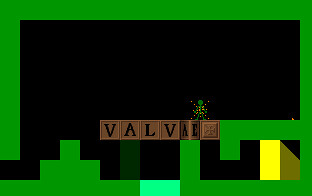
Featured Blog | This community-written post highlights the best of what the game industry has to offer. Read more like it on the Game Developer Blogs or learn how to Submit Your Own Blog Post
The Game-Maker Story: Infoboxes
The sidebars originally composed for the Game Developer Magazine version of the Andy Stone interview

My interview with Andy Stone, creator of Recreational Software Designs' Game-Maker, went through several iterations as it bounced from one publication to the next. When I reformatted it for Game Developer Magazine, I also threw together a couple of infoboxes to help with the layout of the piece. When GDM ceased publication the article fell through, and the sidebar text has since sat neglected in my article folder. Here I reproduce the compact version, to sit alongside the earlier Gamasutra Blogs edition of the interview, entitled "The Making and Unmaking of a Game-Maker Maker". (Also note the outtakes from that interview.)
Games of Note
Although Game-Maker vanished before the Web came to bear, some of its fruits live on in posterity. Fans of the more extensive DOS archives may recognize a few design highlights.

Badman II: He's Back Again (PPP Team, 1996)
Badman series (PPP Team, 1995-96)An increasingly elaborate series of action platformers by the Belgian demo group PPP Team, that masks the engine’s usual quirks behind a refined Euro design sense. The ambitious third game was partially lost due to extreme hard drive failure, but lives on in an incomplete form.

Blinky 2: The Return of Blinky (Jeremy LaMar, 1994)
Blinky series (Jeremy LaMar, 1994-95)A varied action-adventure series by MegaZeux superstar Jeremy LaMar, renowned for its long presence on AOL Kids. One of the few Game-Maker series to transcend RSD's engine and thrive on its own merits, gaining a large cult following. The author himself is puzzled with the intensity of his fans’ passion.

Dummy Duck 7 (beta) (Alan Caudel, 2013)
Dummy Duck series (Alan Caudel, 1992-present)Two decades of wacky and varied platformer action, based on an occasional comic strip. Each game explores new techniques, which can border on the avant garde. Games 2 and 3 were staples of the shovelware CD-ROM scene. Recently Caudel has returned to the series with a new bag of tricks.

Paper Airplane (Matt Bell, 1993)
Paper Airplane (Matt Bell, 1993)One of the most widely distributed Game-Maker games; an action puzzler by Matterport founder Matt Bell, built around gravity and air currents. An early demonstration of the variety of design language permitted by the engine's simple on-off variable structure.

Parsec Man 3D (Mark Hadley, 1994)
Parsec Man 3D (Mark Hadley, 1994)An anaglyphic 3D space shooter/platformer by Slender: The Eight Pages designer Mark Hadley, with a very contemporary-feeling indie design style not unlike Hero Core or Love+. Hadley trades ambition for discipline, and turns out a minor classic. RSD also distributed this with Game-Maker 3.0.
Design Hacks / Advanced Techniques
Out of the box, Game-Maker feels very limited. Advanced users turn its boundaries into just another building block.

Monster Buffering in Builder (A-J Games, 2011)
Monster Buffering (Overworld, Builder, Dummy Duck 7, Man Game, Mine-Maker, The Fantastic Adventures of Byron Solomon)Make the character birth a monster that dies immediately, but ups a counter before it goes. In the next frame, have the character interact with a feature that's sensitive to the counter. In a third frame, birth a second monster that resets the counter – in case of a bad keypress. Voila; now you can open doors, enter pipes, build and destroy blocks, charge super jumps...

Active Time Battles in Man Game RPG (Alan Caudel, 2012)
Active Time RPG battles (Man Game RPG, Dummy Duck 7)Or you can get really crazy. Radically increase the delay after moves, and use the last few frames to slowly fill a meter drawn on the character sprite. Use gravity to pull him/her to the left; use complex monster animation and chains to make a foe occasionally lunge from the right. On death, have the foe birth a pixel-sized key that invisibly teleports to the character's position, opening up an unseen door to the left.

Simulated Parallax in Mortal Harvey (James Faux, 1995)
Simulated Parallax (Mortal Harvey, Ninja Tuck II, Hurdles, Intec)Draw a repeating pattern and use tile animation to make it loop left or down, one pixel at a time. Do it with another pattern, two pixels at a time. And so on. Design a static level, and build encroaching solid obstacles out of monster sprites. Time how long it takes the monsters to loop around the map; at the end, have an invisible door open and use gravity to pull the character in.

QTE Sequences in Adventure (Alan Caudel, 1995)
QTE Sequences (Adventure, etc.)Design a tile-conservative full-screen animation, depicting a perilous situation. Use gravity to place an invisible character at the lower edge. During the active time window, open an invisible door to the side of the character. A correct keypress enters the goal; newly deadly tiles ensure that an incorrect one leads to death – as will waiting too long.

Sprite Whips in Invasion of the Blobs II: The Evolution Revolution (Mike Perrucci, 1998)
Sprite Whips (Invasion of the Blobs II, Blinky 2, Rodip: Rover of the Deep)Have a character or background block rapidly birth monsters, moving quickly toward or away from the character or in a particular pattern. Have the monsters die after just a few ticks. The result is a trail of sprites from birth to death. Now time the animation frames so that each appears at a certain point of the trail. Presto; you have a persistent multi-segmented… thing. Enjoy!
—
EJR Tairne is a freelance writer and editor, sometime game theorist, and general grump. He has written lots of stuff for the Gamasutra family of publications. Most if it is pretty grumpy. You can read more grumpy things on his grumpy blog, that he updates whenever he feels like it.
Read more about:
Featured BlogsAbout the Author(s)
You May Also Like







.jpeg?width=700&auto=webp&quality=80&disable=upscale)








